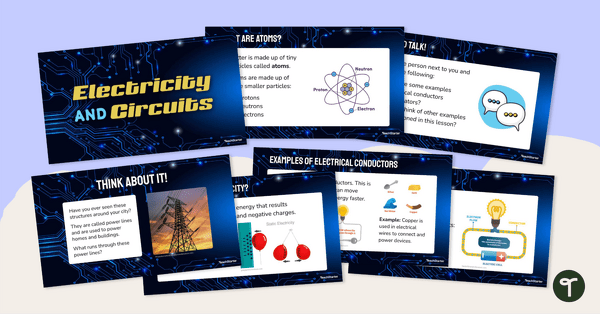Spark curiosity and illuminate young minds with the wonders of electricity. Download this simple circuit diagram to light up your classroom!
What Is an Electrical Circuit?
Are your students learning about circuits this year? This fascinating topic allows students to understand the basics of electricity and how the different parts work together. Whether this is your first year teaching this science concept or perhaps you’ve been away for some time, the teachers at Teach Starter have put together a quick primer to help you and your students understand what an electrical circuit is!
An electrical circuit is a closed pathway through which electric current flows. It consists of various electrical components, such as wires and switches, connected to enable electricity flow.
Here’s a basic breakdown of the key components of an electrical circuit:
Power Source – This is usually a battery or an electrical outlet that provides the energy needed to move electric charge through the circuit.
Load – These are devices that use electrical energy to perform tasks. Examples include light bulbs, motors, heaters and electronic gadgets.
Switches – These are devices that can open or close the circuit, allowing you to control when the electricity flows and when it doesn’t. When a switch is open, the circuit is broken, and when it’s closed, the circuit is complete.
Looking for an Electrical Circuit Diagram?
Teach Starter has created a reference sheet for your 4th grade students to use when learning about electrical circuits. This poster comes in both color and black and white.
This poster can be used in a science center, hung on a bulletin board, or even distributed to students to put in their science notebooks to reference during their electricity unit.
How to Get Your Simple Circuit Diagram
If you are ready to get your hands on this science poster for your young learners, head on over to the green download button! Here, you will find the quick-print PDF file as well as the editable Google Slides document. Both the color and black and white versions are in the same file. If selecting the Google Slides option, please note that you will first be prompted to make a copy of the resource to your personal drive before accessing it.
More Circuit Activities for Your Lesson Plans!
Make sure to check out some of our additional circuit-related resources below!
[resource:4696174] [resource:4861397] [resource:2676582]












0 Comments
Write a review to help other teachers and parents like yourself. If you'd like to request a change to this resource, or report an error, select the corresponding tab above.